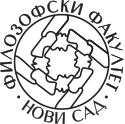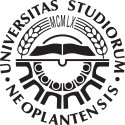15SJSJ056 - Correlations between Serbian and Hungarian Literatures
| Course specification | ||||
|---|---|---|---|---|
| Course title | Correlations between Serbian and Hungarian Literatures | |||
| Acronym | 15SJSJ056 | |||
| Study programme | Serbian Language and Literature for Ethnic Minorities | |||
| Module | ||||
| Type of study | first degree undergraduate academic studies | |||
| Lecturer (for classes) | ||||
| Lecturer/Associate (for practice) | ||||
| Lecturer/Associate (for OTC) | ||||
| ESPB | 3.0 | Status | ||
| Condition | Oblik uslovljenosti | |||
| The goal | Introduction to Serbian–Hungarian literary and cultural contacts from the Middle Ages until today. | |||
| The outcome | Recognizing mutual traits and differences between Serbian and Hungarian culture and literature. | |||
| Contents | ||||
| Contents of lectures | Introduction to the methods of contemporary comparatistics (culturological approach, the notions of tradition, region, and foreign context). Differences and similarities between Serbian culture in the Middle Ages, and the culture of the Kingdom of Hungary. Serbian culture at the dawn of a new era. Hungarian literary and historic figures in the South Slavic epic tradition. The characteristics of the Serbian and Hungarian Enlightenment. The decasyllable in the poetry of the Hungarian Romantics. The Hungarian short story from the end of the 19th century in the context of the Serbian short story from the same period. Serbian and Hungarian Modernism. Stereotypes about the Balkans in the works of Hungarian post-modern writers. The South-Slavic cultural space from the viewpoint of Hungarian authors in Vojvodina, Serbia. Danilo Kiš and Hungarian poets. The reception of Serbian post-modern prose in Hungary. | |||
| Contents of exercises | Excerpts from Serbian and Hungarian literature are read and compared, epic poems about the Ugričić families, poems of Hungarian Romantics written in the so-called Serbian manner, translations-adaptations of Jovan Jovanović Zmaj, Dezső Kosztolányi’s Belgrade travelogue, and excerpts from Ottó Tolnai’s autobiography Költő disznózsírból [Poet of Lard] are interpreted, and the Hungarian intertexts in the prose of Danilo Kiš and his view of Central Europe are analysed. | |||
| Literature | ||||
| ||||
| Number of hours per week during the semester/trimester/year | ||||
| Lectures | Exercises | OTC | Study and Research | Other classes |
| 2 | 2 | |||
| Methods of teaching | Monological-dialogical method, interpretative and interactive method, and discussion in the practical classes. | |||
| Knowledge score (maximum points 100) | ||||
| Pre obligations | Points | Final exam | Points | |
| Activites during lectures | 20 | Test paper | ||
| Practical lessons | Oral examination | 60 | ||
| Projects | 20 | |||
| Colloquia | ||||
| Seminars | ||||

